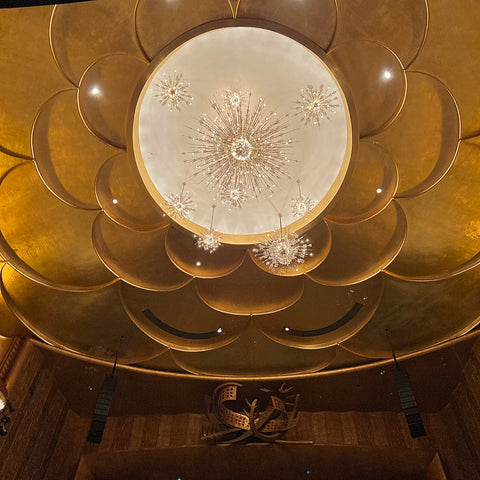
After a brutal, nine hour drive through a torrential (and continuous) Spring storm, we finally arrived at the Emerald City. It never fails: each and every time I exit the Holland Tunnel into Lower Manhattan, I exclaim, "Civilization! I'm back!"
We came to New York City for a few days to see our accountant, visit friends, attend other events, and have a little fun. I also was delivering a customer's purchase—something a bit too delicate to ship easily.
After arriving at our hotel—later than planned—we unpacked and took a little pre-show nap. We had tickets that evening for the Metropolitan Opera: Franco Zeffirelli's Turandot. Any evening in the Metropolitan Opera House is an event. The enormous proscenium arch, the rising chandeliers, even the scalloped ceiling (pictured above) are monumental—tastefully grand.
Productions like Zeffirelli's Turandot are the reason I go to the opera. This delicious spectacle—overwhelming in its scale and ambition—is a feast for the senses. As I sat in the darkened hall, I realized that there are probably few places on Earth where one can see a live stage performance delivered with such bravado. The production expense is out-of-reach of most opera companies. In truth, the Met probably couldn't afford to build the same production from scratch today. The company's 1987 investment (with the notoriously extravagant Zeffirelli) has paid dividends, indeed. Hearing 200 opera singers blasting at top volume is a sensation for the ages.
But Franco's nearly four-decade-old production is not the company's first lavish Turandot. The Met's first Turandot was mounted in 1926 (just seven months after its world premiere in Milan). It was designed by the incredible Austrian-born architect-designer Josef Urban who was the Met's "in-house designer" at the time (his daughter designed the clothes). In 1961, the Met produced a new Turandot for their old opera house (on 39th Street), scenery and costumes designed by Cecil Beaton (also no stranger to aesthetic exuberance). When Zeffirelli designed his version, it was the first Turandot built for the new, modern Lincoln Center location (opened in 1966). The designer took full advantage of the opera house's cutting-edge technical advancements like hydraulic lifts and gigantic wings into which one can move large scenic pieces. (In the old, Midtown Opera House, sometimes large pieces of scenery had to be pulled into the street to get them out of the way.)
Today, some people take offense at operas like Turandot and many opera companies will steer-clear for political (if not economic) reasons. To these people, the very notion of Westerners telling Asian stories (or vice versa) is taboo—any such "cultural appropriation" must be avoided. And, it's true, such interpretations have sometimes perpetuated offensive stereotypes. I, for one (who is part Chinese), am not offended by respectful "Orientalism"—when tastefully and admiringly executed. To be clear, I never expect such works to be "authentic." Rather, I view them as an interpretation of one artist's cultural aesthetics by an artist from another culture (and, possibly, time). In such a re-telling, the artwork becomes something new and different from the original. Turandot—composed by an Italian, designed and directed by an Italian, sung in America by a Russian, a Frenchman or a Spaniard—is a glorious hybrid of many different cultures, aesthetics and sensibilities. With this kept in-mind, one can let go and enjoy being immersed in the exceptional grandeur. Here is a short promotional video clip of Turandot's final moments, provided by the Metropolitan Opera. (Click here.)
Though our Greenwich Village store is now permanently closed, LEO Design is still alive and well! Please visit our on-line store where we continue to sell Handsome Gifts (www.LEOdesignNYC.com).
We also can be found in Canonsburg, Pennsylvania, at The Antique Center of Strabane (www.antiquecenterofstrabane.com).
Or call to arrange to visit our Pittsburgh showroom (by private appointment only). 917-446-4248

